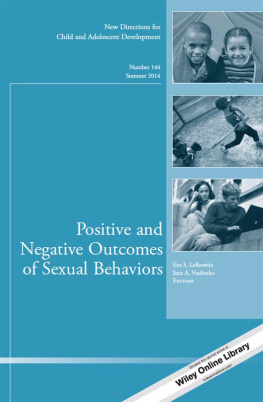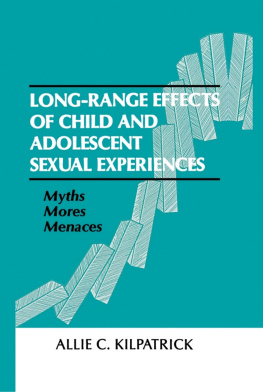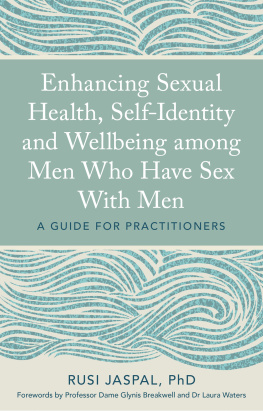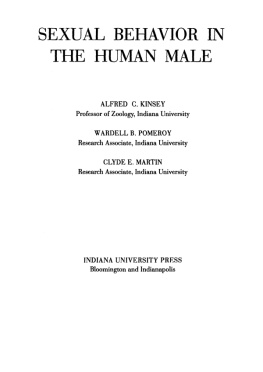
Positive and Negative Outcomes of Sexual Behaviors
Eva S. Lefkowitz, Sara A. Vasilenko (eds.)
New Directions for Child and Adolescent Development, no. 144
Lene Arnett Jensen, Reed W. Larson, EditorsinChief
2014 Wiley Periodicals, Inc., A Wiley Company. All rights reserved.
No part of this publication may be reproduced, stored in a retrieval system, or transmitted in any form or by any means, electronic, mechanical, photocopying, recording, scanning, or otherwise, except as permitted under Sections 107 or 108 of the 1976 United States Copyright Act, without either the prior written permission of the Publisher or authorization through payment of the appropriate percopy fee to the Copyright Clearance Center, 222 Rosewood Drive, Danvers, MA 01923; (978) 7508400, fax (978) 6468600. Requests to the Publisher for permission should be addressed to the Permissions Department, John Wiley & Sons, Inc., 111 River St., Hoboken, NJ 07030, (201) 7486011, fax (201) 7486008, www.wiley.com/go/permissions.
Microfilm copies of issues and articles are available in 16 mm and 35 mm, as well as microfiche in 105 mm, through University Microfilms, Inc., 300 North Zeeb Road, Ann Arbor, Michigan 481061346.
ISSN 15203247electronic ISSN 15348687
New Directions for Child and Adolescent Development is part of The Jossey-Bass Education Series and is published quarterly by Wiley Subscription Services, Inc., a Wiley company, at Jossey-Bass, One Montgomery Street, Suite 1200, San Francisco, CA 94104-4594. Postmaster: Send address changes to New Directions for Child and Adolescent Development, Jossey-Bass, One Montgomery Street, Suite 1200, San Francisco, CA 94104-4594.
New Directions for Child and Adolescent Development is indexed in Cambridge Scientific Abstracts (CSA/CIG), CHID: Combined Health Information Database (NIH), Contents Pages in Education (T&F), Educational Research Abstracts Online (T&F), Embase (Elsevier), ERIC Database (Education Resources Information Center), Index Medicus/MEDLINE (NLM), Linguistics & Language Behavior Abstracts (CSA/CIG), Psychological Abstracts/PsycINFO (APA), Social Services Abstracts (CSA/CIG), SocINDEX (EBSCO), and Sociological Abstracts (CSA/CIG).
Individual subscription rate (in USD): $89 per year US/Can/Mex, $113 rest of world; institutional subscription rate: $388 US, $428 Can/Mex, $462 rest of world. Single copy rate: $29. Electronic onlyall regions: $89 individual, $388 institutional; Print & ElectronicUS: $98 individual, $450 institutional; Print & ElectronicCanada/Mexico: $98 individual, $490 institutional; Print & ElectronicRest of World: $122 individual, $524 institutional.
Editorial correspondence should be emailed to the editorsinchief: Lene Arnett Jensen ().
JosseyBass Web address: www.josseybass.com
A Message From the New Editor-in-Chief
It is with both excitement and trepidation that I announce my new role as Editor-in-Chief of New Directions in Child and Adolescent Development (NDCAD), starting with the Spring 2015 issue. It is exciting because the nature of this journal is very different from a typical professional journal. It is fretful because it will be difficult to fill the shoes of the previous keepers of the journalBill Damon, who inaugurated it in 1978, and Reed Larson and Lene Arnett Jensen, who have minded it since 2005.
I have been among the journal's admiring readers for a long time, having always looked to it when working on literature searches for my own work. Over the years, I have valued this source, which covers fields of developmental science that are either new or transformative. Thus, I take my hat off to Bill for the initial idea, and to Reed and Lene, who have nurtured that idea so well.
In thinking about my turn with the journal, I have read and reread Reed and Lene's transition message published in 2005 (doi:10.1002/cd.131); I agree with each and every thought of their message. The journal will remain edgy, and its edginess will be rooted in the solid-stone foundation and embedded in the relevant developmental context. Yet, it will include some new features.
First, for the first time, NDCAD will have an Editorial Board. I am fortunate to have secured the participation of an outstanding group of junior and senior scientists and practitioners, who, collectively, will make sure that the journal is as avant garde as Bill envisioned, as wide and broad in its coverage as the developmental sciences have become since 1978, and as geographically and culturally diverse as the world in which children and adolescents live. We have divided (approximately, of course) the dimensions of the field among the Board members, and each of us will oversee our dimension and solicit new submissions; and, of course, the Board will always consider unsolicited proposals. Baptiste Barbot (Pace University, USA), Damian Birney (University of Sydney, Australia), Fumiko Hoeft (University of California, San Francisco, USA), Linda Jarvin (Paris College of Art, France), Peggy McCardle (private sector, USA), David Preiss (Catholic University of Chile, Chile), and I (Yale University, USA, and Moscow State University for Psychology and Education, Russia) will work hard to focus on leading-edge ideas and solicit contributions from groups who can appraise these ideas and share their views with the field of child and adolescent development. So, here I switch from I to we, as the changes below represent the Board's collective thinking.
Second, in accordance with the spirit of the time (and impact factors), we will institute a peer-review process for every issue. Every submission will be peer-reviewed: this process will neither delay nor jeopardize the novelty and innovativeness of the content. We acknowledge that peer review has its positives and negatives. We hope to capitalize on the plusses by providing peer feedback on submissions and minimizing the inherent conservatism of peer review. The Editorial Board and I will work closely with issue editors to ensure that every issue is as strong and as quickly produced as it can possibly be.
Third, given the changing demographics of the world, we want to be particularly sensitive to issues that shed light on children and adolescents living in low- and middle-income countries. The developmental literature has been and still is severely biased toward children and youth in high-income countries, although within these countries they represent a variety of levels of wealth. We want to correct this bias as much as possible.
Fourth, when appropriate and possible, we will solicit comments on policy implications for particular issues. Our agenda includes tightening the connections between science and policy. NDCAD can be an effective forum for such efforts.
As we are preparing for the journal's transition in leadership, we welcome your feedback on the changes we outlined above and look forward to any suggestions you may have. But most of all, we are anticipating learning from and teaching about the future of the field as it shapes itself and as the journal shares with readers the field's transformations and innovations. The focus of our agenda is, with your help, to outline the field's zone of proximal development: the field's tomorrow.
Elena L. Grigorenko
Emily Fraser Beede Professor of Developmental Disabilities
Child Study Center
Epidemiology and Public Health
Psychology
Yale University
Vasilenko, S. A., Lefkowitz, E. S., & Welsh, D. P. (2014). Is sexual behavior healthy for adolescents? A conceptual framework for research on adolescent sexual behavior and physical, mental, and social health. In E. S. Lefkowitz & S. A. Vasilenko (Eds.),
Next page










